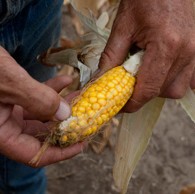 The U.S. lays claim to over half of the globe’s corn exports and nearly the same for soybeans. Nobody else comes close. China, runner-up in the corn category, exports less than half the amount America does. The same is the case for Brazil when it comes to the soy market.
The U.S. lays claim to over half of the globe’s corn exports and nearly the same for soybeans. Nobody else comes close. China, runner-up in the corn category, exports less than half the amount America does. The same is the case for Brazil when it comes to the soy market.
The majority of each ends up as feed for livestock raised abroad, and additional bazillions of tons of corn and soy beyond our exports go toward the domestic production of meat that we export (it takes roughly 10 lbs of grain to grow 1 lb of meat). All told, we shipped $53 billion dollars worth of all three—corn, soy, and meat—in 2011.
But global warming has made 2012 the hottest year since we began keeping records in 1895. A third of the country’s counties have been declared federal disaster areas on account of drought. Crops across the Midwest (88% and 87% of the country’s corn and soy supply, respectively) have been burned brittle and brown. That’s driven corn prices up 45% since mid-June and soybean prices nearly 30% since the beginning of that month and nearly 60% since the end of last year.
The drought has nailed other crops as well, of course, just as global warming does more than raise the temperature. Domestic wheat prices are up 50% since June, and irregular, nearly continuous rain across Europe has flooded-out many wheat crops. A lack of rain has slammed wheat crops in Russia, Ukraine, and Kazakhstan hard, and India, where July is the critical month for planting, has thus far received 20% less of its average rainfall this year.
And that’s less food for everybody tied into the global food network. Less wheat means less bread. Less corn means less processed foods and less industrial-agri meat. Less feed also means less dairy, because dairy cows eat less solid matter and drink more water, thinning out milk and diminishing output.
And when you have less of a commodity the costs go up.
The cost of beef will rise between 4% and 5% next year. Dairy will climb 3.5% to 4.5%. It’s not a starvation situation for most; many folks will just have to eat less meat, and in China, where meat consumption is skyrocketing along with the growth of a middle class, the corn crop is doing okay.
But an increase in the expense of food hits the poor hard. And folks buying meat, corn, and soy from a country with lower prices than the U.S. hits the U.S. market hard. That agricultural trinity accounts for 10% of our exports. Lowered water levels on waterways like the Mississippi and Ohio mean boats have to lighten their load, further reducing exports.
The National Weather Service says the drought will get worse.
And the World Bank says we can expect these higher food prices until at least 2015.
Image from The New York Times
